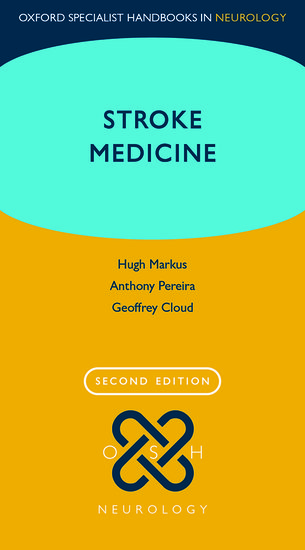When asked by your boss, ‘Would you like to review a book? You’ll get a free copy,’ how could you refuse? And so, I had my first experience of reading a textbook cover to cover. 596 pages later, I had learnt a few things – how to say ‘no’ in the future … and quite a lot about Stroke Medicine too!
This textbook is written by Hugh Markus – Professor of Stroke Medicine, Anthony Pereira – Consultant Neurologist and Geoffrey Cloud – Consultant Stroke Physician, representing the three key areas of expertise in Stroke – academic neuroscience, clinical neuroscience and internal medicine. It is aimed at Stroke Trainees and Stroke Consultants (from Neurology and General Medicine backgrounds). As a Geriatrics registrar, I work regularly in Stroke and unsurprisingly found the book to be very instructive. For those without a specialist interest in Stroke, however, the authors portray Stroke, its prevalence, its diagnosis and the management of its long term sequelae, in the context of the NHS as a whole.
The textbook is full of useful facts, easy to read and good illustrations (such as those intended to show patients in relation to risk factors). Depending on how much you need to know, the authors provide ample information but also cover the basics in easy to follow language. Those looking to know it all can read on; those who need to know the basics can access what they need. The authors break down some very complex topics – neuroanatomy and ‘stroke syndromes’ – into manageable chunks, providing good revision material for exams and a good reference point for a difficult topic.
As well as describing the pathology and pharmacological treatment of stroke, the textbook covers history-taking and examination skills. This highlights the importance of a thorough history to make the diag- nosis, and to identify risk factors and anticipate future problems. Clear definitions of clinical findings are given, along with the methods for recognising them. The section on the cranial nerves is especially strong in this regard.
There are real-life examples of acute stroke images, alongside some MR Physics and explanations of what specific MR sequences signify. I feel this has given me more confidence to ask the right questions when working with radiologists, especially ‘out of hours’: may we have gradient echo, please? I will also know when to drop in the transcranial Doppler option; that machine is in the corner of the stroke unit, but I’ve never seen it turned on. On a more basic level, the authors also explain the rationale for traditional tests in the acute setting, for example ECG for old Myocardial Infarction, Left Ventricular Hypertrophy or Atrial Fibrillation or Chest X-Ray for Pneumonia or Congestive Cardiac Failure. These may be critical data but if the tests are done without thought, the findings may not be given their due weight. Where relevant, as in the use of ASPECTS to assess CT, the authors provide links to websites where you can practise.
I often deal with intracranial bleeds and always refer to the neurosurgeons. Cases are discussed, and either managed conservatively or transferred for urgent neurosurgical intervention. I am therefore comfortable to undertake conservative management, but largely unaware of procedures and outcomes in the neurosurgical group. The chapter ‘Cerebral Haemorrhage’ clearly explains all the options from medical management such as Nimodipine in Subarachnoid Haemorrhage, to endovascular and surgical intervention in intraparenchymal bleeds. This has given me some perspective of what’s available ‘out there’.
The textbook cites a multitude of trials and other studies relating to different areas of treatment. Where formal evidence is lacking the authors lend their authority to pragmatic approaches, offering reassurance to front-line clinicians uncertain as to when to anticoagulate for atrial fibrillation following acute stroke, when to perform carotid endarterectomy following transient ischemic attack and so on.
As a doctor on a stroke unit, my input can often seem minimal as, following the diagnosis and initiation of treatment, the input is mainly from physiotherapists, occupational therapists, speech and language therapists, dieticians and nursing staff. The chapter “Recovery and Rehabilitation” recognises the crucial importance of each player in the clinical team.
The authors have a holistic approach to management of stroke, from thrombolysis and thrombectomy to managing post-stroke depression. They do cover the critical moments in the life of an on-call ‘med reg’ (and the patient) such as seizures or severe hypertension in the acute stroke. However, clearly laid out lists of pros and cons of thrombolysis would have been useful along with flow charts on how to manage specific acute problems. That being said, perhaps that very specific guidance of this kind has to be sought from locally determined protocols.
Overall, this textbook is a great source of information, for trainees and established clinicians working in the Stroke field – whether as Geriatricians, Acute Medicine specialists or Neurologists. If only I could be sure of recalling the key information at the key moment, success would be guaranteed. In any case, I am comforted by having an easy point of reference for all my queries on Stroke.
